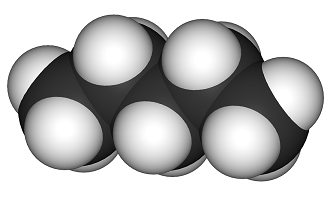Pentane
Pentane is a hydrocarbon that can be burned as a fuel. Its chemical formula is C5H12 and it is a volatile, colourless liquid with a characteristic gasoline-like odour.[2] The properties of pentane are very similar to butane and hexane. As well as being used as fuel, pentane has numerous industrial uses. Primarily, pentane is used to create a blowing agent which is then used to create a foam known as polystyrene. Polystyrene is used to make insulation materials for refrigerators and heating pipes.[3] As well, pentane is used in geothermal power stations as a "binary" fluid, due to its low boiling point.[4]
As is the case with other hydrocarbons, pentane undergoes hydrocarbon combustion, combining with oxygen to form carbon dioxide. The balanced chemical equation for the complete combustion of pentane is:
Properties
Below is a table of some of the basic properties of pentane.
| Formula | C5H12 |
| Molar mass | 72.15 grams/mole |
| Melting Point | -130oC[5] |
| Boiling Point | 36oC[5] |
References
- ↑ "Pentane-3D-space-filling". Licensed under Public Domain via Wikimedia Commons - http://commons.wikimedia.org/wiki/File:Pentane-3D-space-filling.png#mediaviewer/File:Pentane-3D-space-filling.png
- ↑ National Center for Biotechnology Information. (2015). Properties of Pentane [Online]. Available: http://pubchem.ncbi.nlm.nih.gov/compound/pentane#section=Experimental-Properties [February 16, 2015].
- ↑ Cornell Biochem. (2015). Pentane [Online]. Available: https://cornellbiochem.wikispaces.com/Pentane#Uses [February 16, 2015].
- ↑ Willie Scott. (November 15, 2010). Geothermal Power Plants [Online]. Available: http://www.brighthub.com/environment/renewable-energy/articles/53953.aspx [February 16, 2015].
- ↑ 5.0 5.1 Charles E. Ophardt. (2003). Virtual Chembook - Hydrocarbon Boiling Points [Online]. Available: http://www.elmhurst.edu/~chm/vchembook/501hcboilingpts.html [February 16,2015].


